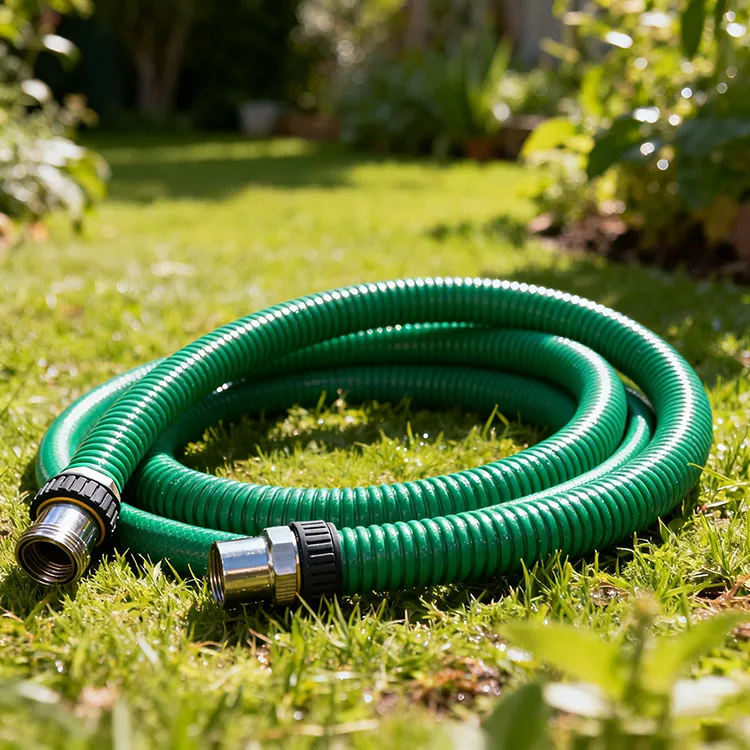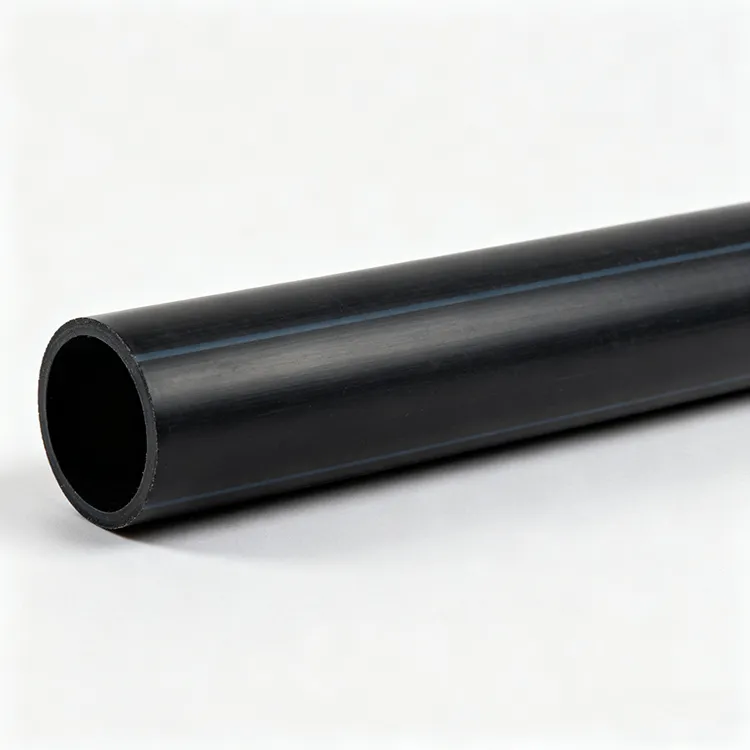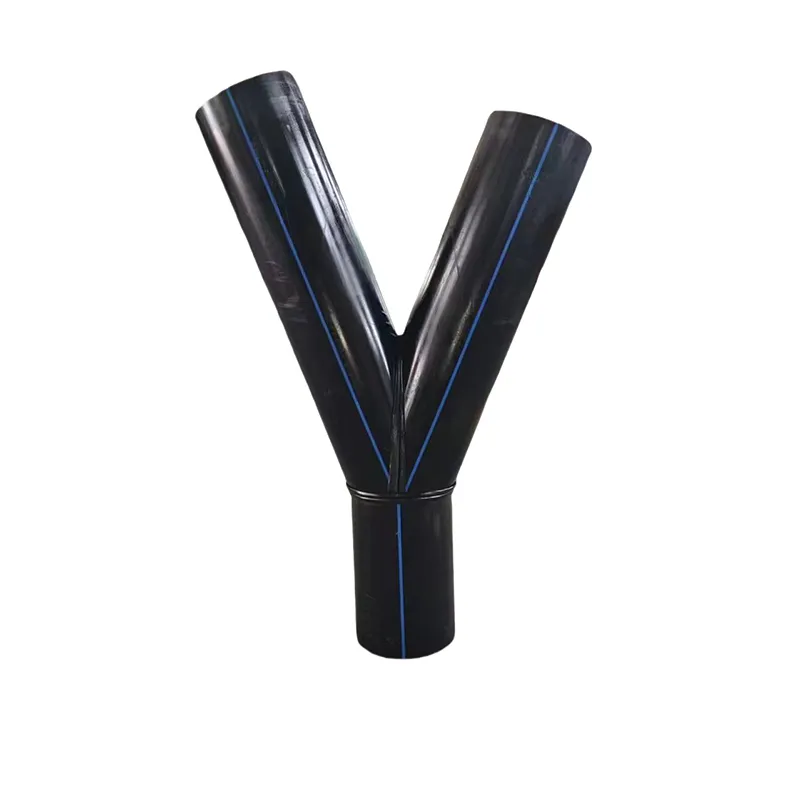Classification of HDPE Pipes
HDPE (High-Density Polyethylene) pipes can be categorized based on their applications and functions as follows
1. HDPE Water Supply Pipes
Features: Black pipe body with blue stripes.
Applications: Mainly used for municipal water supply, building plumbing, and rural drinking water projects.
Advantages: Corrosion-resistant, hygienic, and long-lasting.
2. HDPE Gas Pipes
Features: Black pipe body with yellow stripes.
Applications: Used for transporting natural gas and liquefied petroleum gas.
Advantages: High flexibility, pressure-resistant, and adaptable to ground settlement.
3. HDPE Sewer Pipes
Features: Typically solid black or marked with other stripes.
Applications: Used for discharging sewage, industrial wastewater, and rainwater.
Advantages: Chemically resistant with excellent impact resistance.
4. HDPE Electric Protection Pipes (MPP Pipes)
Features: Usually orange in color with a thick structure.
Applications: Serve as protective conduits for power and communication cables.
Advantages: Good insulation and high compression resistance.
5. HDPE Corrugated Pipes
Features: External surface has a corrugated pattern, and the interior is smooth.
Applications: Commonly used in municipal drainage and sewer projects, especially for underground installation.
Advantages: Lightweight, easy to install, and excellent pressure resistance.
6. HDPE Irrigation Pipes
Features: Black pipe body with green stripes or solid black.
Applications: Used in agricultural irrigation, garden watering, and greenhouse irrigation.
Advantages: Weather-resistant, flexible installation, and cost-effective.
7. HDPE Double-Wall Corrugated Pipes
Features: Corrugated outer wall and smooth inner wall, with possibly different inner and outer colors.
Applications: Primarily used in underground drainage and sewage systems.
Advantages: High strength and low installation costs.
8. HDPE Mining Pipes
Features: Black or other colors, with enhanced impact resistance.
Applications: Used for mine drainage and slurry transportation.
Advantages: Wear-resistant, pressure-resistant, and corrosion-resistant.
| Type | Identification Color | Main Applications | Features |
| HDPE Water Pipes | Black + Blue Stripes | Water supply | Hygienic, durable |
| HDPE Gas Pipes | Black + Yellow Stripes | Gas transportation | Flexible, pressure-resistant |
| HDPE Sewer Pipes | Black | Sewage management | Corrosion-resistant, sturdy |
| HDPE Irrigation Pipes | Black + Green Stripes | Agricultural irrigation | Weather-resistant, economical |
| HDPE Corrugated Pipes | Black | Drainage, sewage | Lightweight, durable |
HDPE pipes are widely recognized for their versatility and reliability in various applications, each tailored to specific needs such as water supply, sewage management, irrigation, and more. Among these, HDPE gas pipes stand out due to their critical role in ensuring the safe and efficient transportation of natural gas and other gaseous fuels. In the following section, we will focus on HDPE gas pipes, exploring their unique features, advantages, and applications in greater detail.
627675.webp)
What role does the HDPE gas pipe play in the HDPE pipe line?
In the HDPE pipeline system, HDPE gas pipe plays a vital role, which is mainly reflected in the following aspects:
1. The core role of safe transportation
HDPE gas pipe is designed for the transportation of natural gas and liquefied petroleum gas. Its materials and structures have excellent pressure resistance, corrosion resistance and permeability resistance. This ensures the safety of gas during transportation and avoids potential risks such as leakage.
2. Key nodes connecting energy
As an important part of the energy transportation network, HDPE gas pipe connects energy supply points and consumer ends. In urban gas supply, industrial gas and rural clean energy promotion, HDPE gas pipe plays an indispensable bridge role.
3. High-performance stable guarantee
Compared with traditional material pipelines, HDPE gas pipe can maintain stable performance in complex terrain and harsh environments with its excellent flexibility and resistance to geological settlement, thereby ensuring the long-term operation of the gas pipeline network.
4. Representative of energy saving and environmental protection
HDPE gas pipe is light in weight and easy to install, which not only reduces transportation and construction costs, but also reduces the impact on the environment. In today's context of emphasizing sustainable development, its application also reflects the concept of environmental protection.
In summary, HDPE gas pipe is responsible for the safe, efficient and environmentally friendly energy transportation in the HDPE pipeline system, and is an irreplaceable and important part of the entire pipeline network.
582578.webp)
Overview of HDPE Gas Pipes
HDPE gas pipes are specially designed high-density polyethylene pipelines for transporting natural gas and liquefied petroleum gas (LPG). Due to their outstanding performance and reliability, HDPE gas pipes are widely used in modern gas transportation systems.
Features of HDPE Gas Pipes
1. Excellent Flexibility
Can adapt to ground settlement and environmental changes, preventing pipe breakage or leakage.
2. Superior Corrosion Resistance
HDPE materials are highly resistant to chemical corrosion, performing exceptionally well in acidic, alkaline, or humid environments.
3. High Strength and Pressure Resistance
Can withstand the high pressure generated during gas transportation, ensuring safe operation.
4. Lightweight and Easy Installation
Compared to traditional metal pipes, HDPE pipes are lightweight, making transportation and installation more efficient.
5. High Gas Tightness
Joints formed by heat fusion or electrofusion create a seamless connection, eliminating leakage risks and enhancing safety.
6. Long Service Life
Under normal conditions, the lifespan of HDPE gas pipes exceeds 50 years, reducing maintenance costs.
Applications of HDPE Gas Pipes
1. Urban Gas Supply
Main and branch pipelines for natural gas transportation in urban networks.
2. Industrial Gas Transmission
Large-scale gas transportation for industrial facilities such as boilers and heating equipment.
3. Rural Clean Energy Projects
Gas networks in rural development projects to replace traditional coal energy.
4. Specialized Engineering Applications
Suitable for environments requiring high safety and flexibility, such as pipelines across seismic zones.
Installation Methods for HDPE Gas Pipes
1. Heat Fusion Connection
The ends of the pipes are heated and fused using a heat fusion machine, forming a strong joint after cooling.
2. Electrofusion Connection
Electrofusion fittings are heated to fuse the pipes and fittings together.
3. Flange Connection
Commonly used in scenarios requiring removable joints for easier maintenance.
Advantages of HDPE Gas Pipes Compared to Traditional Pipes
| Criteria | HDPE Gas Pipes | Traditional Metal Pipes |
| Flexibility | Excellent | Poor |
| Corrosion Resistance | Superior | Susceptible to corrosion |
| Gas Tightness | High | Prone to leakage |
| Ease of Installation | Easy | Relatively complex |
| Service Life | Over 50 years | 20–30 years |
HDPE gas pipes, with their safety, efficiency, and durability, play a crucial role in gas transportation. Whether in urban gas networks or rural clean energy projects, they provide a reliable solution for ensuring energy security and safe delivery.









659.webp)
210.webp)
328.webp)

294.webp)
476.webp)


